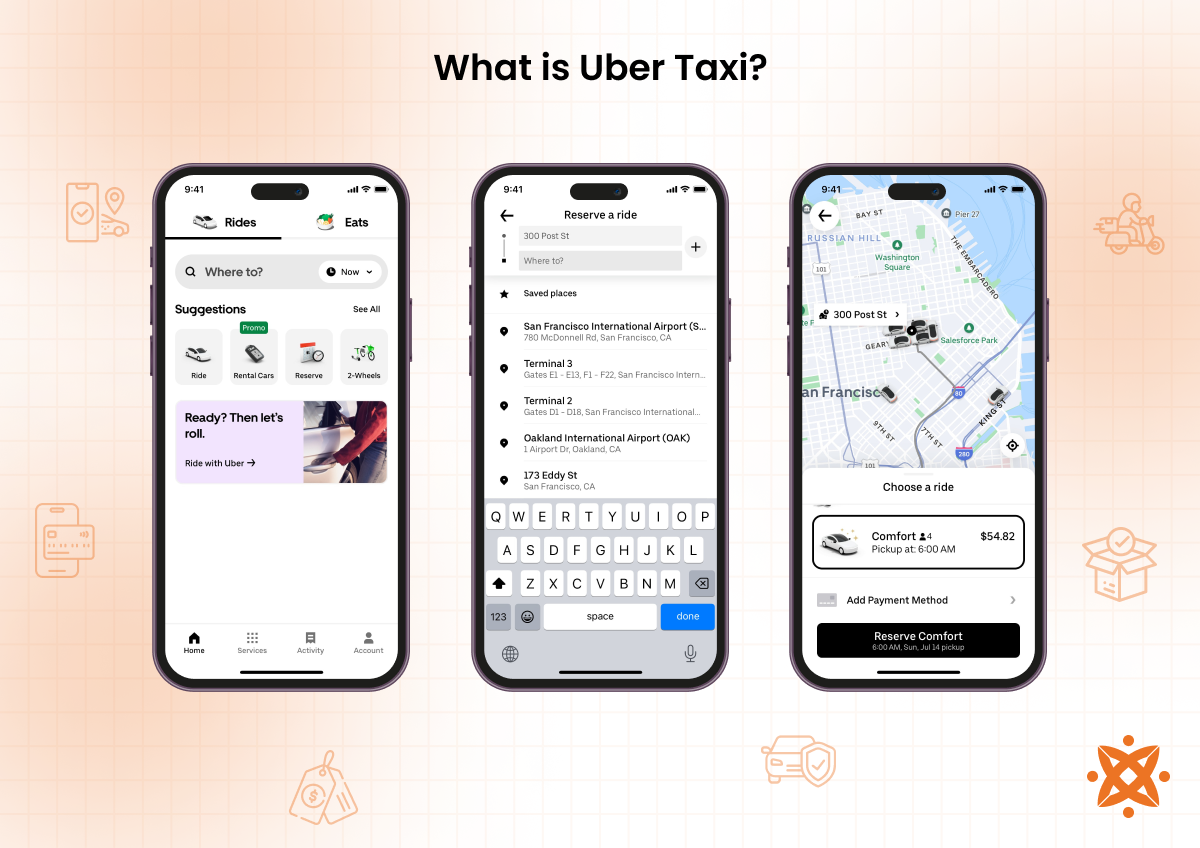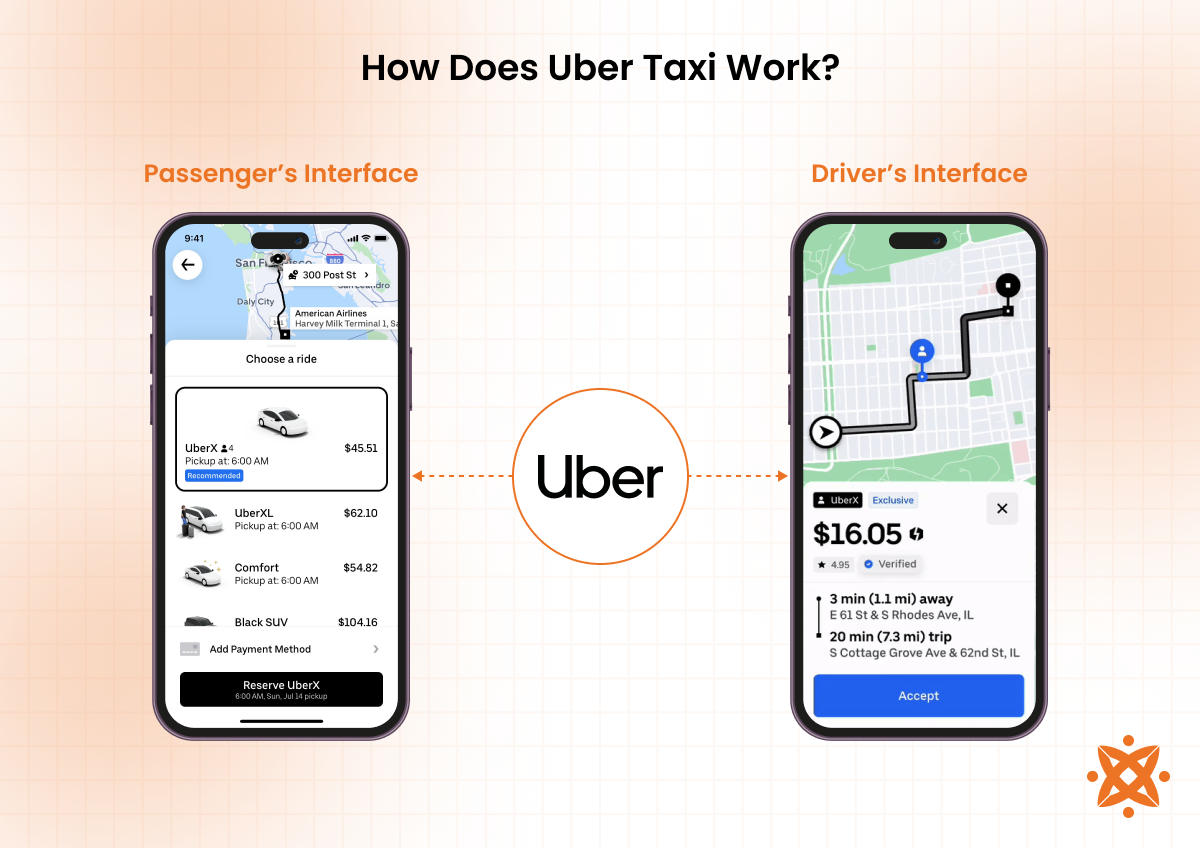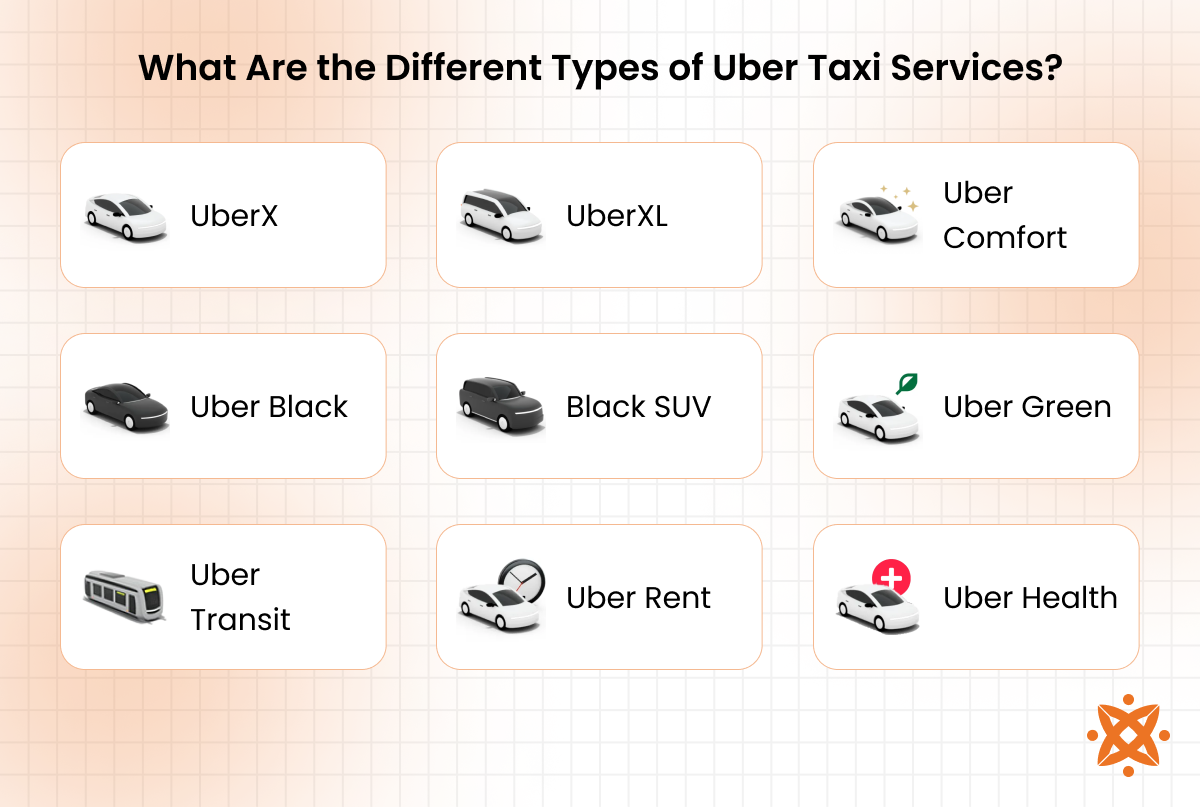
Uber Taxi operates as an on-demand cab booking service connecting passengers with drivers through a mobile app. Users request a ride, track the driver in real time, and pay securely within the app. Advanced algorithms match passengers with the nearest drivers, minimizing wait times and optimizing ride efficiency.
Uber Taxi works by connecting passengers and drivers through a mobile app. Passengers input pickup and drop-off locations, request a ride, and are matched with the nearest driver. The app provides real-time ride tracking and secure in-app payment. Dynamic pricing adjusts fares based on demand and driver availability.
According to Statista Research Department, in a publication dated April 8, 2024, Uber facilitated over 7 billion trips globally in 2022, with an average ride request fulfillment time of under 4 minutes in urban areas.
Different types of Uber Taxi services include UberX for standard rides, UberXL for larger groups or extra luggage, Uber Black for premium rides with high-end vehicles, UberPOOL for shared rides, and Uber Comfort for rides with extra legroom and a more relaxed experience.
Uber Taxi requirements for passengers include the Uber app and a valid payment method to book rides. For drivers, requirements include a valid driver's license, vehicle registration, background checks, and vehicles meeting local regulatory standards.
Uber Taxi is available in the UK, including cities like London, Manchester, Glasgow, Leeds and Birmingham. It complies with local regulations to provide reliable transportation.
According to Uber's newsroom publication titled "Uber is now in over 10,000 cities globally" on February 28, 2020, the company operates in over 10,000 cities worldwide, providing a variety of ride-sharing options to millions of users daily.
Joining Uber Taxi as a passenger requires downloading the Uber app, creating an account, and linking a valid payment method. Drivers need to submit a valid driver's license, proof of insurance, vehicle registration, and complete background checks before they can begin accepting ride requests.
Building a taxi app like Uber starts with market research to define user needs and features such as ride booking, real-time tracking, and payment integration. The process involves developing the app's front-end and back-end, integrating APIs for maps and payments, and conducting rigorous testing.
Essential features include dynamic pricing, customer support, and a driver rating system. The cost ranges from £15,000 to £45,000, depending on the app's complexity and features.
What is Uber Taxi?
Uber Taxi is a ride-sharing service that connects passengers with drivers through a mobile app, offering affordable, reliable, and on-demand transportation. It allows users to book rides by entering pickup and drop-off locations, track their ride in real-time, and pay digitally, providing a seamless and cashless experience.

What makes Uber Taxi unique is its dynamic pricing system, which adjusts fares based on demand and availability, ensuring ride availability even during peak hours.
Features like real-time tracking, a driver rating system ensuring safety and quality, along with multiple ride options including shared rides and premium services, set Uber Taxi apart from traditional taxi services.
The history of Uber started in 2009 when it launched as UberCab in San Francisco. The company quickly expanded internationally, rebranded to Uber, and pioneered the concept of app-based ride-sharing. By 2022, Uber operated in over 10,000 cities worldwide and facilitated more than 7 billion rides globally.
According to the Statista Research Department, in a publication dated June 5, 2024, Uber recorded an average ride request fulfillment time of under 4 minutes in urban areas. In 2022, Uber's gross bookings exceeded $137 billion, reflecting its widespread usage and dominance in the ride-sharing industry.
How Does Uber Taxi Work?
Uber Taxi works by connecting passengers with drivers through a mobile app. Passengers enter their pickup and drop-off locations, request a ride, and the system matches them with the nearest available driver using advanced algorithms.
The app provides real-time tracking of the driver's location and estimated time of arrival. Once the ride is complete, payment is processed digitally within the app, offering a cashless experience.
Dynamic pricing adjusts fares based on demand and driver availability, ensuring service efficiency during peak hours or high-demand periods.

What Are the Different Types of Uber Taxi Services?

The different types of Uber Taxi services include:
- UberX
UberX offers affordable rides for individuals or small groups with standard vehicles. It is the most commonly used service, providing cost-effective transportation with up to four passengers.
- UberXL
UberXL is designed for larger groups or passengers needing extra luggage space. It provides rides in SUVs or minivans that accommodate up to six passengers.
- Uber Comfort
Uber Comfort offers a premium experience with vehicles that provide extra legroom. Passengers can also customize their ride preferences, such as temperature and conversation level.
- Uber Black
Uber Black provides a luxury ride experience with high-end vehicles and professional drivers. It is ideal for business travelers or those seeking premium transportation.
- Black SUV
Black SUV is a luxury service for larger groups, offering high-end SUVs that accommodate up to six passengers. It ensures a premium experience with professional drivers.
- Uber Green
Uber Green provides eco-friendly rides in electric or hybrid vehicles, reducing the environmental impact while maintaining affordability and reliability.
- Uber Transit
Uber Transit integrates public transportation schedules and options into the app, helping users plan their journeys with a mix of Uber rides and transit services.
- Uber Rent
Uber Rent allows users to book rental cars directly through the app for personal or business trips. This service offers flexible options for longer-distance travel.
- Uber Health
Uber Health is a service for healthcare providers to schedule and manage transportation for patients. It ensures reliable and timely rides for non-emergency medical needs.
What Are Uber Taxi Requirements?
The requirements for Uber Taxi include specific criteria for drivers, vehicles, and other factors to ensure service quality and compliance:
- Age Requirements
Drivers must be at least 21 years old and have a valid government-issued driver's license. - Driver Requirements
Drivers must complete a background check, which includes criminal history and driving record verification. A minimum driving experience of one year is typically required, or three years for drivers under 23. - Vehicle Requirements
Vehicles must meet local regulations and Uber's standards, including being a four-door car, in good condition, and not older than the allowed model year for the region. - Insurance Requirements
Drivers must provide proof of insurance that meets local legal requirements. Uber also provides additional coverage during rides. - Other Requirements
Drivers need a smartphone with the Uber app installed. Some cities may require vehicle inspections or additional certifications.
Is Uber Taxi Available in the UK?
Yes, Uber Taxi is available in the UK, operating in major cities including London, Manchester, Birmingham, Glasgow, and Leeds. It serves millions of users annually, with Uber facilitating over 700,000 trips per day across the UK, reflecting its widespread usage and popularity. The service offers various ride options, including UberX for standard rides, UberXL for larger groups, Uber Comfort for enhanced experiences, and Uber Green for eco-friendly rides.
Anyone with access to the Uber app and a valid payment method can use the service, including locals and visitors. Uber drivers in the UK earn an average of £15 to £20 per hour, depending on factors like location, time of day, and demand. These earnings, combined with flexible working hours, make it a popular choice for drivers seeking additional income.
Is Uber App Cheaper Than a Taxi?
Yes, the Uber app is often cheaper than traditional taxis, particularly for short to medium-distance rides. According to a study by My London Transfer, published on January 15, 2023, Uber is more cost-effective for trips under 5 miles within central London.
Uber offers various ride options, including UberX for affordable rides, UberPOOL for shared and lower-cost travel, and Uber Green for eco-friendly transportation. These options provide flexibility based on budget and preferences.
Anyone with the app and a valid payment method can use Uber, making it widely accessible to both locals and travelers. Drivers on the platform earn an average of £15 to £20 per hour in the UK, offering competitive earnings compared to traditional taxi drivers.
A 2018 study titled "Uber vs. Taxi: A Driver's Eye View" found that Uber drivers have a 30% higher capacity utilization rate compared to traditional taxi drivers. This operational efficiency allows Uber to offer fares that are 10% to 20% lower on average, making it a more cost-effective choice for passengers in urban areas.
Is There a VAT on Uber Taxi Fare?
Yes, VAT (Value Added Tax) is included in Uber Taxi fares in regions where it is required by local regulations. In the UK, Uber fares include a VAT rate of 20% as part of the total cost, ensuring compliance with national tax laws.
This VAT is applied automatically and reflected in the fare shown to passengers during the booking process. The inclusion of VAT does not require passengers to take additional steps, as it is managed entirely by Uber's platform and documented on the trip receipt for transparency.
How to Join Uber Taxi?
To join Uber Taxi as a passenger, download the Uber app, create an account with your personal details, and link a valid payment method. Once the setup is complete, you can access the on-demand cab booking service, check driver availability updates, and book rides seamlessly.
To join as a driver, submit an application through Uber's official website or app, providing a valid driver's license, proof of insurance, and vehicle registration. You must also pass a background check and ensure your vehicle meets Uber Taxi service standards.
After approval, you can start accepting ride requests, benefit from customer service support, and maintain service quality through the driver rating system.
How to Build a Taxi App Like Uber?
To build an Uber taxi app, start by identifying key features such as real-time ride tracking, a driver rating system, a fare estimate calculator, and integrated payment processing. Conduct market research to understand user needs and competition, then design a prototype to outline the app's functionality and user interface.
To develop the app, program the front-end and back-end, and integrate APIs for maps, payment gateways, and notifications. Test the app rigorously to ensure seamless performance across devices and platforms. To address urban mobility solutions effectively, ensure the app is scalable, secure, and user-friendly, meeting the expectations of both drivers and passengers.
What is the Difference Between Uber Taxi and Uber Eats?
The main difference between Uber Taxi and Uber Eats lies in their purpose and services. Uber Taxi is a ride-sharing app that connects passengers with drivers for on-demand transportation, while Uber Eats is a food delivery app that connects customers with restaurants and delivery partners for meal delivery.
Other differences include their operational features and target users. Uber Taxi uses real-time ride tracking and a driver rating system to ensure safe and efficient transportation, focusing on urban mobility solutions.
Uber Eats, on the other hand, integrates restaurant menus, order tracking, and payment systems to provide a seamless food delivery experience. Additionally, Uber Taxi drivers transport passengers, whereas Uber Eats delivery partners handle food deliveries. Both services operate on the Uber platform but cater to distinct user needs.
Never Miss an Update From Us!
Sign up now and get notified when we publish a new article!
Oliver Baker
Co-Founder
Oliver Baker is a co-founder of Intelivita, a leading Web and Mobile App Development Company based in Leeds, UK. Oliver has been at the forefront of the business, expanding it globally and into new technologies including iOS and Android, AR, VR and Mobile Game applications. Oliver excels in Project Management, Leadership, Quality Assurance and Problem Solving and has qualifications with Prince2 and APM. He aims to develop his skills further through a shared interest with other leaders in the Software Markets and the Clients of Intelivita.

